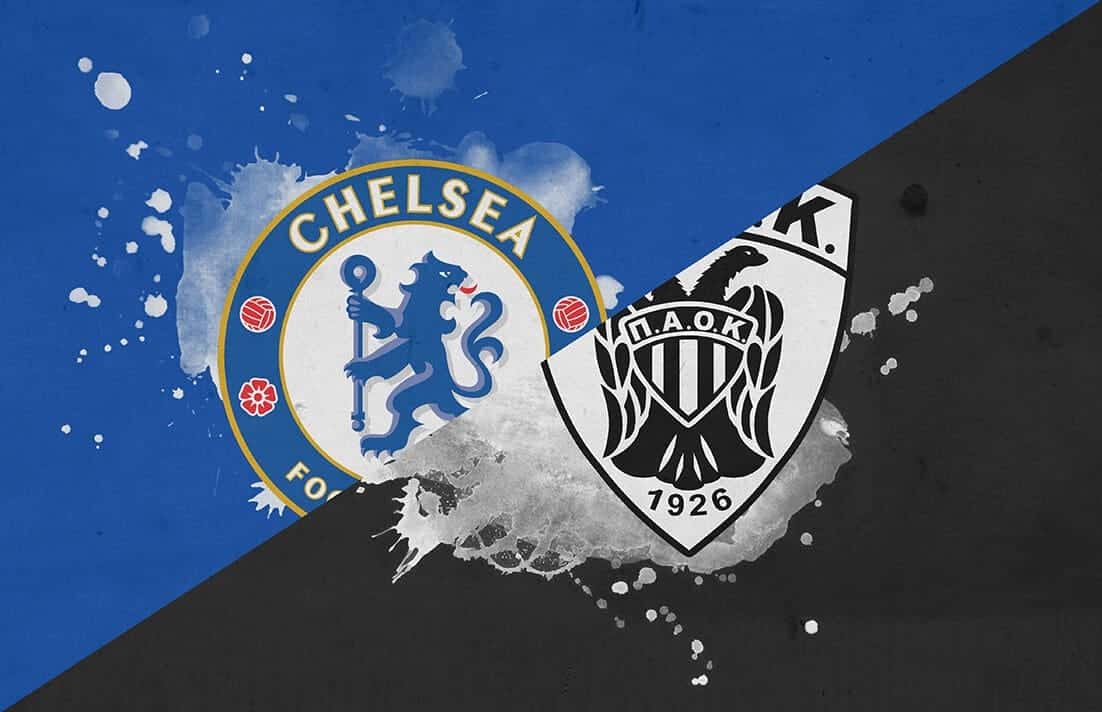With an early red card for PAOK Chelsea were in complete control of the game from the beginning of the match and were rarely troubled defensively. A resounding 4-0 victory and a fifth win out of five put the gloss on Chelsea’s qualification as group winners for the knockout stages of the Europa League. Two goals for Giroud provided a timely boost in confidence heading into a busy December schedule.
Sarri again made a host of changes from the regular Premier League matches, including a rare appearance for Hudson-Odoi and Ampadu gaining some minutes in his development in the second half. These changes presented an opportunity for some of the fringe players to apply pressure on those currently favoured in the premier league by Sarri.
PAOK began the match in a 4-4-1-1 formation with the plan to restrict the impact of Fabregas in the pivot position. After the red card, this became almost impossible for them to do as they fell back into a 4-4-1 which prevented access to Fabregas as Prijovic was unable to cover the distances. Sarri lined Chelsea up in their usual 4-3-3 formation, which has caused some debate in the media after their defeat by Tottenham in the most recent premier league game.
Fabregas Masterclass
With much talk after Chelsea’s defeat to Tottenham focusing on the debate surrounding the positioning of Kante within Sarri’s system, Fabregas displayed a timely reminder of why Sarri prefers a highly technical player in the pivot position. With 112 completed passes in the match, Fabregas was heavily involved in the construction of the build-up play.
Fabregas was at the heart of everything Chelsea did going forward. He offers something slightly different to Jorginho with his ability to play accurate longer passes in behind the defence. This season Fabregas averages 8.43 long passes per game in comparison to 6.05 from Jorginho. Chelsea’s build-up play displayed a heavy emphasis on creating time and space for Fabregas to be able to play forward passes into depth. This enabled Chelsea’s midfielders to position themselves higher up the pitch and threaten the PAOK defence with runs in behind their defensive line.
Pedro’s threat in behind
Pedro provides Chelsea with a different threat to both Willian and Hazard as he is more willing to threaten the space behind the opposition’s defence without the ball. In particular, this proved to be a very effective attacking option for Chelsea in this match.
When Chelsea had possession in deep areas PAOK pushed higher up the field leaving plenty of space behind their defence to exploit. This was often exploited when Fabregas gained possession and as discussed earlier was allowed the time and space to receive the ball without any pressure before lifting his head and finding passes into space.



The Goals
The first Chelsea goal came again from Fabregas collecting the ball in a deep area under no pressure before playing a forward ball behind the PAOK defence for Pedro to run onto. Pedro controlled the ball before manipulating the ball and waiting for support to arrive from his teammates. Giroud moved forwards and moved into space to receive the ball just inside the penalty area before calmly passing the ball into the far corner.
The second goal of the match had a familiar feeling to it as Fabregas again was allowed far too much time on the ball to play another lofted through pass. This time Giroud made the run into space and finished spectacularly on the volley from just inside the box.
Chelsea’s third goal of the game brought another assist for Fabregas as he received the ball just outside the penalty area before playing a simple 10 yard pass into Hudson-Odoi who stepped inside the box onto his right foot before placing the ball inside the near post.
Alvaro Morata completed the scoring by heading in Hudson-Odoi’s cross from the edge of the six-yard box.
Cahill’s build-up play
As this match progressed it became clearer why Cahill is Sarri’s fourth choice centre back. Due to Chelsea’s dominance of both possession and territory, the emphasis was on them to create chances and break down the PAOK defence.
With little pressure being applied to the centre backs and PAOK sitting deeper as the game progressed Cahill would often receive the ball near the halfway line, with all the PAOK players behind the ball. In this situation, Chelsea needed to manipulate the defensive shape of PAOK to create more space for the attacking players.
When Cahill received the ball he rarely played passes forward that broke any lines of pressure, instead opting for the safe option of a sideways pass to Christensen or a short pass into Fabregas. These passes not only allow PAOK to shift short distances to cover the change in position of the ball but it also required another Chelsea player to take part in the build-up play.
Conclusion
The early red card killed the game as a contest, as Chelsea dominated possession and secured top spot in their Europa League group. With an xG of just 0.02, it’s unlikely that Chelsea will have a more comfortable game all season. This was almost the perfect opponent after defeat and Sarri’s consequent criticism of his side against Tottenham. Fabregas and Pedro certainly impressed during this fixture giving Sarri a reminder of their qualities heading into a busy December.
If you love tactical analysis, then you’ll love the new magazine from totalfootballanalysis.com – 118 pages of pure tactical analysis covering topics from the Premier League, Serie A, La Liga, Bundesliga and many, many more. Get your copy today for just £4.99 here!






Comments